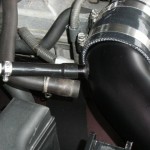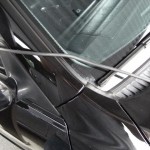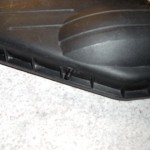 In the last article, I told you that you can easily measure intake restriction using a differential pressure gauge (or simply a vacuum gauge).
In the last article, I told you that you can easily measure intake restriction using a differential pressure gauge (or simply a vacuum gauge).
For whatever reason, nearly no one does this, and it's a shame, as it'd save most people a grip of cash and probably show them that some of the things they've done in the name of performance, didn't actually accomplish much at all - or perhaps also, that it accomplished quite a lot.
I don't like to waste money, and I like to be able to quantify for certain what changes I've made when I do a mod. In this article, I am going to show you how I measured the intake restriction on a 2002 Lexus IS300. However, you can follow these exact steps on ANY car, regardless of the year, make or model.
Getting a Benchmark
 In order to see just how restrictive the stock IS300 intake actually was, I first popped the hood and located the PCV ventilation tube. This is usually a very large vacuum hose that runs from the valve cover to the intake pipe. Some enthusiasts make the mistake of removing this and fitting a breather filter on the valve cover but this is a mistake - one I'll cover in a different article.
In order to see just how restrictive the stock IS300 intake actually was, I first popped the hood and located the PCV ventilation tube. This is usually a very large vacuum hose that runs from the valve cover to the intake pipe. Some enthusiasts make the mistake of removing this and fitting a breather filter on the valve cover but this is a mistake - one I'll cover in a different article.
For now, I just remove the tube from the intake arm and let it hang free, it will temporarily vent any crankcase pressure to the atmosphere which is fine for these tests.
The IS300 has a fairly large PCV vent tube, I created a crude adapter to connect my thinner vacuum hose to the port on the intake arm. The primary reason is that these tests would be done with the hood down and it's much easier to run a vacuum hose from the engine bay to the passenger compartment when the hose is a small diameter.
The size of the vacuum hose, length, etc does not matter as the gauge/meter only measures the pressure at the end of the tube, just make sure it's not kinked. Air is not actually flowing through the tube.
The other end of the hose was then routed through the window and into my differential pressure gauge.
After everything was connected it was time to take the car out for a test drive. I did several WOT runs and recorded the maximum vacuum recorded from all the runs. On this particular car, the faster the car goes, the more is forced into the intake snorkel which sits over top of the radiator and sucks air from the grille area. Therefore, my highest vacuum was seen in 1st gear - a great design by the way, thanks Toyota. Typically, if the car does not suck up air from the grille area or some other forward facing area, the highest vacuum will be seen at peak power in 2nd gear usually.
The highest vacuum recorded was 9.1 inches of water, which, is actually very little. For those of you who are used to PSI, that's 0.327psi of "negative boost". Generally speaking, getting below 5 inches of water for "total intake restriction" (what we've just measured) is extremely difficult and would be considered superb.
To give you an idea, a bad intake system would maybe register something like 27-30 inches of water. A phenomenally good one would be well, around 4-9 inches of water.
I actually repeated these tests over a period of a year and found the 9.1 peak figure to be repeatable without question.
Finding the Culprits
So now I know that I've got 9.1 inches of water restriction lurking somewhere in the stock intake system. It's not very much compared to some other cars I've measured, but it can still be improved and we can still see sometimes quite large gains from even small changes. Using our trusty gauge, we can now figure out exactly where that restriction is coming from.
In order to do this, you simply plumb in a line wherever you want to measure the  restriction. So, I drilled a tiny hole in the top of the air box, which would tell me how much restriction was from that point to the front of the snorkel. Therefore, I could figure out how much restriction the stock intake snorkel was causing. In the image to the right, you can see the nipple I added. It's a piece I got from the drip irrigation section of the local hardware store. I drilled a hole, used super glue to make it hold firm and a bead of black silicone for good measure. You can either cap these off with a vacuum cap later, or you can do what I did later on and only take measurements by tapping factory vacuum locations.
restriction. So, I drilled a tiny hole in the top of the air box, which would tell me how much restriction was from that point to the front of the snorkel. Therefore, I could figure out how much restriction the stock intake snorkel was causing. In the image to the right, you can see the nipple I added. It's a piece I got from the drip irrigation section of the local hardware store. I drilled a hole, used super glue to make it hold firm and a bead of black silicone for good measure. You can either cap these off with a vacuum cap later, or you can do what I did later on and only take measurements by tapping factory vacuum locations.
I could also take a measurement just behind the air filter to see how much it was causing. With a differential pressure gauge like mine, I can actually plumb two lines in to make this measurement. I plumed one to the hole on top of the air box, and one to a vacuum port behind the air filter. The gauge will then read the restriction at both points and subtract the values to tell me how much pressure drop is occurring between those two points.
Each time I take a measurement I just drive back out on the road and do a few WOT runs to find the peak restriction measured on several test runs.
After taking measurements, here's what I found (note: while the picture above shows an aftermarket intake arm installed, these measurements were with the factory arm installed):
6 in H2O - rear of air box, MAF, intake arm
0.8 in H2O - air filter
2.3 in H2O - snorkel
9.1 inches TOTAL restriction.
As you can see, the air filter causes nearly no restriction at all even with a big 3.0L engine sucking hard on it at 6000+ rpm. In this car, the % of the total restriction it causes is deceptive, in most vehicles you'll find that the air filter is actually a very tiny percentage of the total restriction. Even so, I repeated these measurements with several aftermarket filters (HKS, aFe, K&N) and found that they made absolutely no difference AT ALL. In fact, the drop-in filters for THIS car actually made flow worse because the sides of the filter were closed in, instead of open like the factory filter. This effectively puts a wall in front of about a third of the snorkel's intake, creating restriction to flow.
You'll find that drop-in air filters (And indeed conic filters) do not typically make any difference at all, regardless of what the marketing and forum hype will tell you. You also are taking a gamble on the filtering characteristics of the new filter - the factory one however will ALWAYS filter the air to the manufacturer's specifications. Factory filters are often cheap and re-usable filters are questionable and not really great money math either. Something to think about.
Next time, I'll show how some different modifications affected the total restriction and some surprises that I found along the way. It turns out that for the past 10 years, this car has been running down on power, due to a very subtle problem that I might have never noticed had I not done this research. I also do some simple modifications to reduce the restriction and I'll let you know exactly how much difference it made. I will also share with you the basic ways that you can make these same types of modifications on your car, whatever it may be.
Extremely Limited Time Offer - 3 Days Only
Get a MASTERS DEGREE in Performance Tuning from the BEST in the Field for ONE low package price
For 3 days only, get ALL of our PREMIUM (not available anywhere else) Tuner University Courses featuring some of the greatest minds in motorsports:
- Top 10 Performance Myths Class (MP3 and Edited Transcript) - $29.95 value
- Performance on a Sip of Fuel Class (MP3 and class manual) - $69.95 value
- Header Design Secrets with John Grudynski (MP3 and transcript) - $69.95 value
- Dirty Secrets of Oil with Ryan Stark (MP3 and transcript) - $69.95 value
- Engine Tuning Secrets with Ben Strader of EFI University (MP3 and Transcript) - $69.95 value
Get all of the above courses (many of which not currently available anywhere else) for one single price of just $309.75 $69.95. A HUGE package savings.
You can also buy any of these individually through our resource center, but I don't know why you would as this is basically the whole store for the price of just 1 course. You'll get the MP3 recordings of each class as well as a transcript or companion manual with each course and you'll be able to download them all INSTANTLY.





